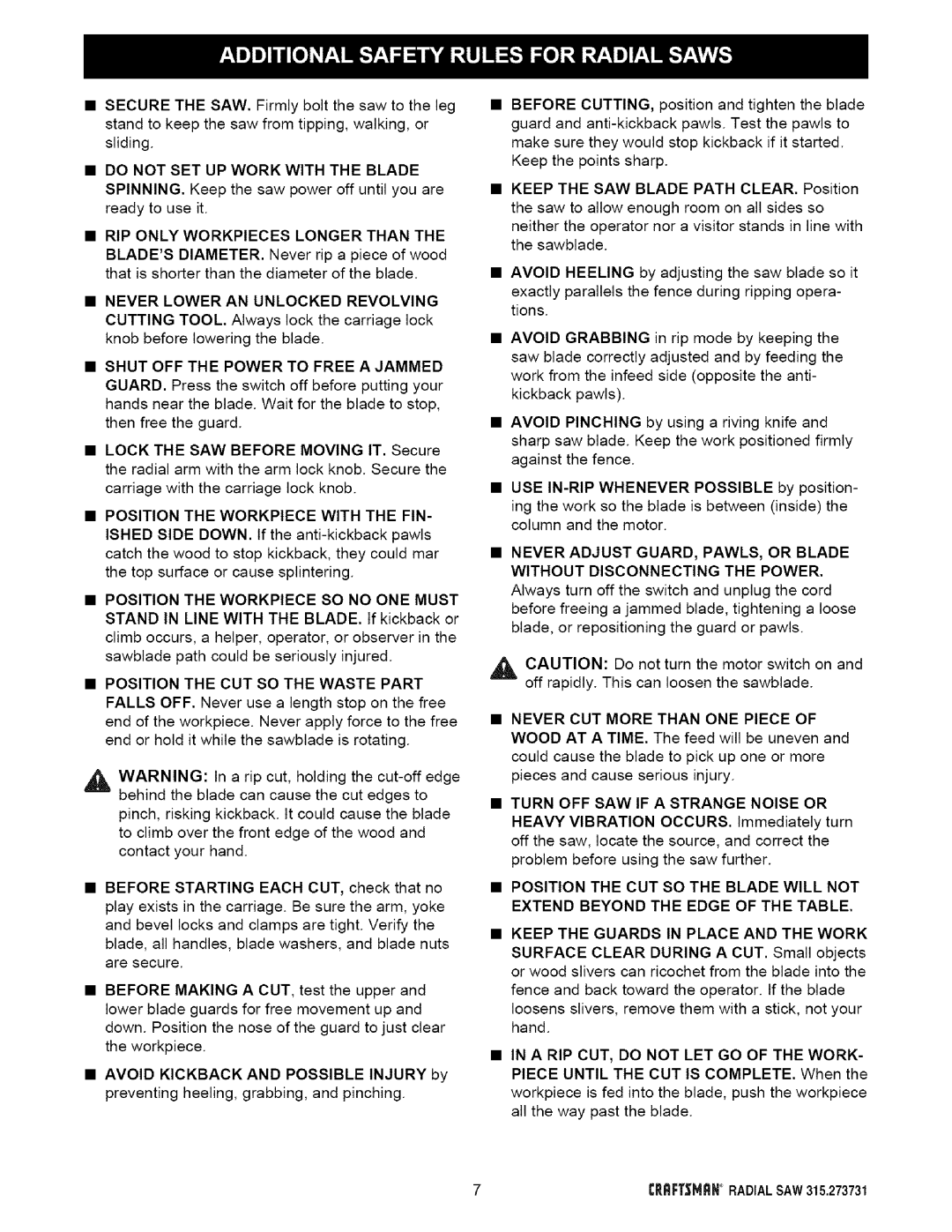
•SECURE THE SAW. Firmly bolt the saw to the leg stand to keep the saw from tipping, walking, or sliding.
•DO NOT SET UP WORK WITH THE BLADE SPINNING. Keep the saw power off until you are ready to use it.
•RIP ONLY WORKPIECES LONGER THAN THE BLADE'S DIAMETER. Never rip a piece of wood that is shorter than the diameter of the blade.
•NEVER LOWER AN UNLOCKED REVOLVING CUTTING TOOL. A(ways lock the carriage lock knob before lowering the blade.
•SHUT OFF THE POWER TO FREE A JAMMED GUARD. Press the switch off before putting your hands near the blade. Wait for the blade to stop, then free the guard.
•LOCK THE SAW BEFORE MOVING IT. Secure the radial arm with the arm lock knob. Secure the carriage with the carriage lock knob.
•POSITION THE WORKPIECE WITH THE FIN- ISHED SIDE DOWN. If the
•POSITION THE WORKPIECE SO NO ONE MUST STAND IN LINE WITH THE BLADE. If kickback or climb occurs, a helper, operator, or observer in the sawblade path could be seriously injured.
•POSITION THE CUT SO THE WASTE PART FALLS OFF. Never use a length stop on the free end of the workpiece. Never apply force to the free end or hold it while the sawblade is rotating.
,_ WARNING: In a rip cut, holding the
pinch, risking kickback. It could cause the blade to climb over the front edge of the wood and contact your hand.
•BEFORE STARTING EACH CUT, check that no play exists in the carriage. Be sure the arm, yoke and bevel locks and clamps are tight. Verify the blade, all handles, blade washers, and blade nuts are secure.
•BEFORE MAKING A CUT, test the upper and lower blade guards for free movement up and down. Position the nose of the guard to just clear the workpiece.
•AVOID KICKBACK AND POSSIBLE INJURY by preventing heeling, grabbing, and pinching.
BEFORE CUTTING, position and tighten the blade guard and
KEEP THE SAW BLADE PATH CLEAR. Position the saw to allow enough room on all sides so
neither the operator nor a visitor stands in line with the sawblade.
•AVOID HEELING by adjusting the saw blade so it exactly parallels the fence during ripping opera- tions.
AVOID GRABBING in rip mode by keeping the saw blade correctly adjusted and by feeding the work from the infeed side (opposite the anti- kickback pawls).
•AVOID PINCHING by using a riving knife and sharp saw blade. Keep the work positioned firmly against the fence.
•USE
ing the work so the blade is between (inside) the column and the motor.
•NEVER ADJUST GUARD, PAWLS, OR BLADE WITHOUT DISCONNECTING THE POWER.
Always turn off the switch and unplug the cord before freeing a jammed blade, tightening a loose blade, or repositioning the guard or pawls.
,_L CAUTION: Do not turn the motor switch on and off rapidly. This can loosen the sawblade.
NEVER CUT MORE THAN ONE PIECE OF WOOD AT A TIME. The feed will be uneven and could cause the blade to pick up one or more pieces and cause serious injury.
TURN OFF SAW IF A STRANGE NOISE OR HEAVY VIBRATION OCCURS. Immediately turn off the saw, locate the source, and correct the problem before using the saw further.
POSITION THE CUT SO THE BLADE WILL NOT EXTEND BEYOND THE EDGE OF THE TABLE.
KEEP THE GUARDS IN PLACE AND THE WORK
SURFACE CLEAR DURING A CUT. Small objects or wood slivers can ricochet from the blade into the fence and back toward the operator. If the blade loosens slivers, remove them with a stick, not your hand.
IN A RIP CUT, DO NOT LET GO OF THE WORK- PIECE UNTIL THE CUT IS COMPLETE. When the workpiece is fed into the blade, push the workpiece all the way past the blade.
